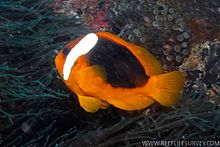| Australian clownfish | |
|---|---|

| |
| Conservation status | |
 Least Concern (IUCN 3.1) | |
| Scientific classification | |
| Domain: | Eukaryota |
| Kingdom: | Animalia |
| Phylum: | Chordata |
| Class: | Actinopterygii |
| Order: | Blenniiformes |
| Family: | Pomacentridae |
| Genus: | Amphiprion |
| Species: | A. rubrocinctus |
| Binomial name | |
| Amphiprion rubrocinctus Richardson, 1842 | |
| Synonyms | |
Amphiprion rubrocinctus, also known as the Australian clownfish or red anemonefish, is a species of anemonefish that is endemic to north west Australia. Like all anemonefishes it forms a symbiotic mutualism with sea anemones and is unaffected by the stinging tentacles of the host anemone. It is a sequential hermaphrodite with a strict sized based dominance hierarchy: the female is largest, the breeding male is second largest, and the male non-breeders get progressively smaller as the hierarchy descends. They exhibit protandry, meaning the breeding male will change to female if the sole breeding female dies, with the largest non-breeder becomes the breeding male. The fish's natural diet includes zooplankton.
Description
The side of A. rubrocinctus has blackish or dark brown sides with red snout, breast, belly and fins. it has a single white head bar that is often poorly developed and lacking a pronounced black margin.
Color variations
Some anemonefish species have color variations based on geographic location, sex and host anemone. A. rubrocinctus does not show any of these variations.
Similar species
A. rubrocinctus is included in the tomato complex and so has similarities with other species in this complex. A. frenatus is similar however males are entirely bright red and the white head bar is more vivid on females. A. barberi was originally thought to be a geographic color variation of A. rubrocinctus but was described as a separate species in 2008. A. barberi lacks the dark brown or black sides and is geographically distinct. A. rubrocinctus is easily distinguished from the 4 other species of anemonefish commonly found within its range. A. perideraion and A. sandaracinos have a distinctive white stripe along the dorsal ridge while A. clarkii and A. ocellaris each have 3 white bars.
-
 A. rubrocinctus (Australian anemonefish)
A. rubrocinctus (Australian anemonefish)
-
 A. frenatus (Tomato anemonefish)
A. frenatus (Tomato anemonefish)
-
 A. barberi (Barber's anemonefish)
A. barberi (Barber's anemonefish)
Distribution and habitat
A. rubrocinctus is only found in the tropical seas of north west Australia, from Ningaloo Reef, Western Australia, to Groote Eylandt in the Gulf of Carpentaria, Northern Territory.
Host anemones
The relationship between anemonefish and their host sea anemones is not random and instead is highly nested in structure. A. rubrocinctus is specialised, being hosted by only 2 out of the 9 host anemones found within its range. A. rubrocinctus is hosted by the following species of anemone:
- Entacmaea quadricolor Bubble-tip anemone (usually)
- Stichodactyla gigantea giant carpet anemone
Conservation status
Anemonefish and their host anemones are found on coral reefs and face similar environmental issues. Like corals, anemones contain intracellular endosymbionts, zooxanthellae, and can suffer from bleaching due to triggers such as increased water temperature or acidification. Characteristics known to elevate the risk of extinction are small geographic range, small local population and extreme habitat specialisation. A. rubrocinctus has only one of these characteristics, being a small geographic range and its ability to use two different anemone hosts may reduce the risk of extinction associated with extreme specialisation. This species was not evaluated in the 2012 release of the IUCN Red List. The Northern Territory Department of Land Resource Management has listed the species as being of least concern.
References
- Jenkins, A.; Allen, G.; Myers, R.; Yeeting, B. & Carpenter, K.E. (2017). "Amphiprion rubrocinctus". IUCN Red List of Threatened Species. 2017: e.T188348A1862245. doi:10.2305/IUCN.UK.2017-2.RLTS.T188348A1862245.en.
- ^ Fautin, Daphne G.; Allen, Gerald R. (1997). Field Guide to Anemone Fishes and Their Host Sea Anemones. Western Australian Museum. ISBN 9780730983651. Archived from the original on 18 October 2014.
- Buston PM (May 2004). "Territory inheritance in clownfish". Proc. Biol. Sci. 271 (Suppl 4): S252–4. doi:10.1098/rsbl.2003.0156. PMC 1810038. PMID 15252999.
- ^ Allen, G; Drew, J; Kaufman, L (2008). "Amphiprion barberi, a new species of anemonefish (Pomacentridae) from Fiji, Tonga, and Samoa". Aqua: Journal of Ichthyology and Aquatic Biology. 14. aqua, International Journal of Ichthyology: 105. hdl:10022/AC:P:14506. ISSN 0945-9871.
- ^ Dianne J. Bray (2011). "Australian Anemonefish, Amphiprion rubrocinctus, in Fishes of Australia". Archived from the original on 24 September 2015. Retrieved 12 September 2015.
- Ollerton J; McCollin D; Fautin DG; Allen GR (2007). "Finding NEMO: nestedness engendered by mutualistic organization in anemonefish and their hosts". Proc R Soc B Biol Sci. 274 (1609): 591–598. doi:10.1098/rspb.2006.3758. PMC 1766375. PMID 17476781.
- Munday P.L. (2004). "Habitat loss, resource specialization, and extinction on coral reefs". Global Change Biology. 10 (10): 1642–1647. Bibcode:2004GCBio..10.1642M. doi:10.1111/j.1365-2486.2004.00839.x. S2CID 84725549.
- Hobbs J.-P.A.; Frisch A.J.; Ford B.M.; Thums M.; Saenz-Agudelo P.; Furby K.A.; Berumen M.L. (August 2013). "Taxonomic, spatial and temporal patterns of bleaching in anemones inhabited by anemonefishes". PLOS ONE. 8 (8): e70966. Bibcode:2013PLoSO...870966H. doi:10.1371/journal.pone.0070966. PMC 3738586. PMID 23951056.
- "Conservation Status of Animals of the Northern Territory" (PDF). Department of Land Resource Management. Northern Territory Government. Archived from the original (PDF) on 29 September 2015. Retrieved 28 September 2015.
External links
- "Amphiprion rubrocinctus". Integrated Taxonomic Information System.
- Amphiprion rubrocinctus. Richardson, 1842. Retrieved through: World Register of Marine Species.
- Froese, Rainer; Pauly, Daniel (eds.). "Amphiprion rubrocinctus". FishBase. November 2014 version.
| Taxon identifiers | |
|---|---|
| Amphiprion rubrocinctus |
|